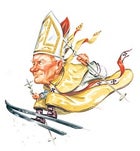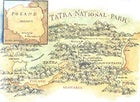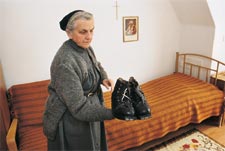God Almighty, you who gave us corporeal life and entrusted us with it, so we would honor and care for it, looks out for the men and women who ski, may they maintain their health and use their free time wisely.


 These boots were made for schussing: ST2 unveils the pope’s old leather waffle stompers.
These boots were made for schussing: ST2 unveils the pope’s old leather waffle stompers.—Pope John Paul II
I’m snooping around the pope’s old bedroom in Kraków, Poland, checking out the gouges on his skis. I confess: I’ve been in a lot of bro-dorms, but none nearly as holy. Usually the decor consists of empty beer cans, a PlayStation, and smelly Capilene underwear. But in the tidy one-room pope pad—now part of the Archdiocesan Museum, located near Wawel Royal Cathedral, where Father Karol Wojtyla hung his skullcap from 1952 to 1958—there’s a dainty caf table, three chairs, a neat bunk with purple cushions, and an armoire filled with colorful priestly garb.
But right now I’m more interested in the two pairs of skis leaning in the corner. One’s an old hickory set with spring bindings and pointy tips, the kind you see hanging over bars in ski towns. The others, retired more recently, are 195-centimeter Head Pros with Tyrolia bindings. I can’t help myself—I have to touch them. The undersides are grooved with deep cuts and scratches. The skis don’t quite qualify as sacred relics, but they do serve notice that when he got away from it all, up in the mountains, Father Wojtyla wasn’t just sticking to the corduroy and cruising the green runs, like Gerald Ford at Beaver Creek. No—he skied over rocks! He was out there, off-piste. The man who became pope in 1978 might, in fact, have been a badass. As I clutch the skis, the docent stares, then quietly reminds me not to take a photograph.
Pope John Paul II is widely known and revered by millions the world over as the spiritual guide and shepherd of the Roman Catholic Church. What is less well known is his history as a trailblazing two-planker. The Man in White ripped the Polish pow from the time the papacy was just a gleam in his eye until his mature years as the toast of the Vatican. In his younger days, JP2 was known as a megahiker, an avid kayaker, and a camper nonpareil. He preached in the woods, ate watery pudding for sustenance while surfing the backcountry, and repeatedly lost his prayer book in the wild. When asked, “Is it befitting a cardinal to ski?” his reply was, “What is unbefitting a cardinal is to ski badly.”
One day I heard a tale from a gentleman I met in my neighborhood in Los Angeles. A draftsman who emigrated to the United States during World War II, he insisted he’d once skied with the pontiff back when His Holiness was a seminary student. As evidence, he produced an out-of-focus photo he claimed was him and a grinning Karol Wojtyla. He pointed to a city park on a map of Kraków and mentioned something about reveling in the outdoors.
Not being a student of papal extra-curricular activities, this beta came as a shock. Up to this point, my interest in Catholicism had been limited to idle thoughts about sin and the Inquisition, but as a skier I was intrigued by the notion of a sportive pope. So I went to Poland on my own secular quest, to seek the holy trail.
It may come as a surprise to the bourgeois Western skier, raised on a diet of fresh powder in the Rockies or the Alps, but southern Poland is carpeted with mountains, chairlifts, and après-ski huts full of sausages and beer. There are four major ski areas and all have names that would garner triple-digit Scrabble scores: Szczyrk. Zakopane. Szklarska Poreba. The Bieszczady Mountains.
Zakopane (the easiest to pronounce: Zock-o-pah-nay) is situated in the Tatra Mountains, a gnarly spur of the Carpathians that crowds the border with Slovakia. Thanks to the mounds of fresh snow that pile up there every year, it is known as the winter sports capital of Poland and a former stomping ground of JP2. Accessible via a well-marked two-lane road, the town lies just a couple of hours south of Kraków, unless you’re stuck behind a horse-drawn vehicle, in which case it takes much longer. Joining me on my journey is Witold Krassowski, a dry-witted photographer with a bushy mustache. Witold’s usual assignments take him to war zones. He can’t understand why anyone would be interested in the pope’s sporting past, but he’s happy to play along, and as a translator he’s invaluable.
As we creep along in our rented Renault, Witold reads aloud from Papiez, Jakiego Nie Znamy (roughly “The Pope in Nature”), a paperback we found among the kitschy glow-in-the-dark Jesuses and cards depicting Catholic saints in 3-D at the apartment in Wadowice (30 miles southwest of Krak-w) where the pope was born in 1920. Now, of course, it too is a museum. Young Karol was studious, serious, and religious, but he also dug the outdoors, and it was in Wadowice that he first strapped hickory sticks to his feet and felt the wind whistle through his hair as he slid down farm hills, past chickens and cows. Later, the freedom of downhilling would take on immense spiritual importance. “In the mountains,” says Witold, quoting the more mature, philosophical pope, “the ugly hubbub of the city disappears and the quiet of immeasurable distances prevails, which allows a person to more clearly hear the inner echo of the voice of God.” Sounds like some hippie telemarkers I know. And yet, JP2 has tapped his ecological veins to add a little more green to a typically anthropocentric religion. He’s gone so far as to declare the worldwide environmental crisis an urgent moral problem and has called on Catholics and all humans to show respect for “the hidden, yet perceivable requirements of the order and harmony which govern nature itself.” Could it be that the foundations he laid for his own brand of peace-and-earth-loving Catholicism as pope are rooted in his powder-loving past?
Well, it seems totally obvious to me. After he was elected to Rome, enough skis arrived from well-wishers to outfit half the Vatican, but the Pontiff resisted the call of the backcountry. “I pray to God to lead me from this temptation,” he said in 1979 to an Italian mountain sports club that had presented him with a pair of custom white boards. “I might yet slide into a ravine, and then what?” (Though he did think to add, “God bless skiers and their legs.” Amen.) Eight years later he proved he was a regular guy by caving in to that temptation. He donned dark glasses, jumped in an Alfa, and sneaked up to a resort in the Rhaetian Alps. It was the last time he was healthy enough to ski. (Since the early nineties, JP2, who is now 81, has had his gallbladder removed, a hip replaced, and has battled what the Vatican calls “symptoms” of Parkinson’s disease.) Still, it certainly lends credence to the Papal Powder Linkage Theory.
Like a lot of post-Cold War Poland, Zakopane is a melange of communist-era concrete hotels and shops mixed in with traditional wooden buildings. Since the fall of communism, the culture seems to have grown more jumbled in appearance, if not in demeanor. Enterprising locals set up tables in the streets to sell football-shaped lumps of smoked sheep’s cheese, which tastes surprisingly like rubber. But the main drag is also packed with restaurants, and a loud Internet cafe adjacent to a skateboard boutique—two sure signs that capitalist tomfoolery is on the rise—is crammed with malcontent punk rockers playing online killing games and kibbitzing in chat rooms. These kids, spiky-haired and fashion-conscious, are the closest thing to ski bums I see the whole time I’m in Poland.
From the center of town it’s a short taxi ride to the burg of Kuznice, where you catch the cable car to the summit of Kasprowy Wierch, the most popular lift-served peak in the country. Crammed inside the cable car on our first morning in Zakopane, the “inner echo of the voice of God” is drowned out by the complex garbled consonants of tightly sandwiched Poles.
In photos, the Tatra Mountains are breathtakingly beautiful; in person, they’re gray and fogbound, magically deep and hobbit-sultry. When we crack through the cloud layer and reach the ski station at the top, the sky is blue, and rocky, snowcapped peaks stretch in every direction.
We pile out of the cable car, 6,500 feet up. Skiers are everywhere, fashionably dressed in understated Eastern European style and carrying the latest equipment. Right out the doors of the station, a modern quad is dropping people off at the top of a gargantuan treeless bowl. The slope is wide-open and the icy terrain is crammed with skiers of all levels, though there are no snowboarders in sight. Being a powder-obsessed American, I traverse as far as possible along the ridge, which also happens to be the Poland-Slovakia border. Shuffling past gun-toting, camo-clad guards, I reach the far edge of the bowl, where last night’s two centimeters of fresh hasn’t been decimated. Then I shove off.
It’s a tough crowd on Kasprowy; people take their skiing very seriously. There’s no whooping or heckling, even when there’s a total crashing yard sale. I’ve learned that wearing colors other than dark neutrals is a fashion faux pas, but I can’t help feeling that people are looking at me suspiciously. Witold claims it’s the scrap of pink lining on my navy blue Patagonia jacket—the bright color makes me look freakish and foreign. By the time I reach the bottom, my wave of paranoia has passed. Strange vibes and muted slope excitement are just something else to get used to in this reserved culture.
When Karol Wojtyla was the Bishop, and later Cardinal, of Kraków, he was still a ripper, and he spent two weeks each winter from 1962 to 1978 with the Sisters of St. Ursula Grey in their convent just down the road from Kasprowy. Witold, who has had to deal with nuns a lot over the years, says they are incorrigible gossips. Don’t believe anything they say, he advises, but I believe it all anyhow.
The day after our trip up Kasprowy, we comb our hair and knock on the convent door. We are greeted by two nuns, both named Sister Theresa. Sister Theresa No. 1, pleasant and brisk, introduces us to Sister Theresa No. 2, an older woman eager to talk about the pope. ST2 takes us upstairs to view the pope’s old lodgings. It’s less of a museum than the other museums, but it’s still set up exactly as he left it. The desk, chairs, and table have that behind-the-Iron-Curtain institutional look, all blond wood and modular. Standing here, I realize that at this point I’ve been in more bedrooms belonging to the pope than to any other man.
In the corner is a black-and-white shot of the then-bishop, skis on his shoulder, wool hat pulled down over his ears. He’s wearing a nylon jacket with a broken zipper. ST2 tells Witold that the skiing bishop was a fashion disaster—his goggles were outdated, his clothes mismatched. She tells him this confidentially, in Polish, giggling, saying it’s not to be translated. Witold immediately translates for me, happy to prove his point about nuns with wagging tongues.
ST2 is full of dope on the pope, most of which supports my vision of him as a hard-core downhiller. He skied Kasprowy, she says, but preferred the solitude of the Chocholowska Valley, about ten miles to the west. He would drive into the valley, park, climb a mountain, and carve his way to the bottom. “He was critical of skiing as sport,” ST2 opines. “And he didn’t think taking a cable car up a hill and then going down was sport. The only way he’d go skiing was to carry skis up the mountain and ski down.”
Visible through the convent’s windows are the slopes of Nosal, a small Zakopane ski hill with poma lifts and a rope tow. ST2 tells me that one night long ago, the bishop arrived at the convent at midnight, couldn’t resist the allure of fresh powder, and took off for a run. But then, she adds, he would rarely go into the mountains alone. When I ask why, ST2 explains that to be a prominent Catholic clergyman in a communist country in the midst of the Cold War was dangerous. Police would dress up as sheep in nearby fields as he frolicked, she says. It’s hard to tell what she means—were the police masquerading as sheep to spy on him or to protect him?—but I love the idea of fuzzy baaaing cops hunched over in meadows wearing heavy woolen costumes. Witold doesn’t believe a word of it.
As we’re about to leave, I ask the sisters if they have a pair of the pope’s old boards around. No, all his skis are in the museum in Kraków, they say. “We have his boots, though,” ST1 offers. She leaves and comes back with a well-worn pair of leather ski boots, laces up both the front and back. She handles these relics lovingly, setting them on a desk for us to admire. The pope, it turns out, has average-size feet.
In Poland, Pope John Paul II is everywhere—on plaques and posters, in sculptural simulacra, and as the namesake of the Szlak Papieski, aka the Papal Trail, a hiking and ski route that stretches for three miles in the spruce forests of the Chocholowksa Valley. I expected the official Papal Trail to ascend dramatically heavenward, but no dice. In fact, it moseys for most of its length along a creek that meanders through the valley. Trees are marked with the colors of the Vatican, yellow and white, and the trail is dotted with small crosses adorned with tired-looking Jesuses, shivering in the Carpathian wind.
We leave the Renault behind at a Tatra National Park kiosk and jump into a horse-drawn sleigh, the traditional method of accessing the Papal Trail if you’re not hiking or skiing. As we plod along, snow starts falling in clumps. Soon it’s as misty and atmospheric as a Zeppelin box set. Visibility is so low we can’t even make out 6,165-foot Mount Rakon, another of the pope’s old haunts. After a mile, our carriage reaches the Papal Trail; we get out and start to walk. Hikers pass us going the other way, and some are on downhill skis, which seems odd, given that the trail is nearly flat. One man trudges by alone. I ask where he’s coming from and he replies, sullenly, “From up to down.” I brace myself for an uphill rally, but the trail peters out at a makeshift shrine of candles and crosses. It’s a bit of a letdown.
The day after, I say good-bye to Witold and decide to follow the pope’s footsteps on my own. This means going deeper into the Tatras, to a “refuge,” or inn, that lies on the banks of a small alpine lake called Morskie Oko, “Eye of the Sea.” There are eight refuges in Tatra National Park, and they’re open year-round. In summer they’re often filled to capacity, but in winter the trans-Tatra trails get a lot of snow, leaving only the most hardy souls to trek in.
After an hour’s drive east to the village of Lysa Polana, I park again and hoof the six-mile trail to Morskie Oko solo. The refuge looks a bit more rickety than I’d been led to expect. On my map there’s a photo of a spiffier building perched beside emerald-green waters and surrounded by mountains, but today everything is uniformly white. I walk toward where I think the lake might be until I hear ice creaking beneath my feet. I’m on it.
I turn around and make my way back to the refuge. Downstairs, in a wood-paneled dining room, the proprietress brings out a photo album and shows me snapshots of a surprise visit the pope made in 1997. When she was a little girl, the future pope would visit Morskie Oko for one or two nights at a time during July and August, bringing youth groups to the mountains. She points to a picture of JP2 in ’97, standing on the shore. He’s wearing white robes and a matching windbreaker. “He remembered my parents,” she says in halting English. “Nice man, very nice man.”
After the sun sets, the bright white landscape turns to gray and then black. I’m served roast chicken and cabbage salad, which I eat alone in the dining room. There are three other people spending the night, but they are nowhere to be seen.
���ϳԹ���, the “quiet of immeasurable distances” fills the crisp night air and the Tatras breathe with the solitude and wonderment that nourished the pope during campouts, ski trips, and kayaking adventures. It’s my last night in Poland, so I take another walk atop the lake he’s paddled across and delivered sermons beside. It’s dark, but I can just make out a cross nailed up on a nearby tree—a reminder, I’m guessing, in case visitors become so distracted by the splendor that they forget about the nuts and bolts of the equation. I listen again for that inner echo of the voice of God, but hear only muffled voices, nothing more mystical than my three fellow refugees, out for a late-night smoke.


